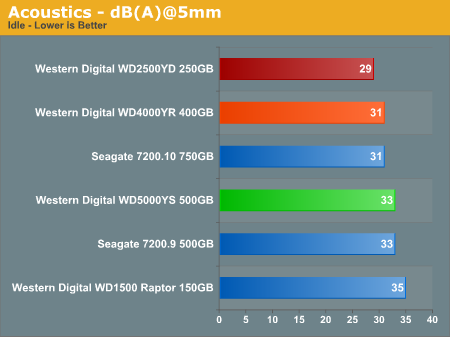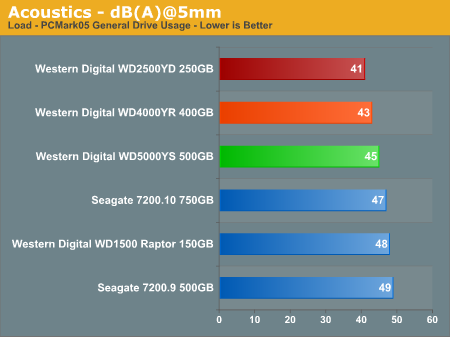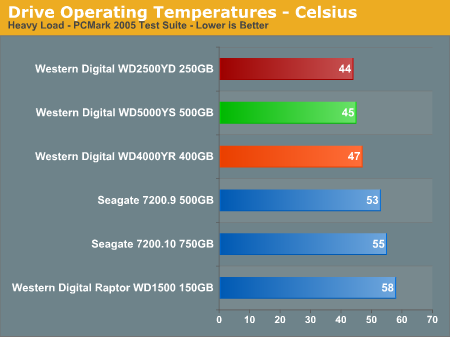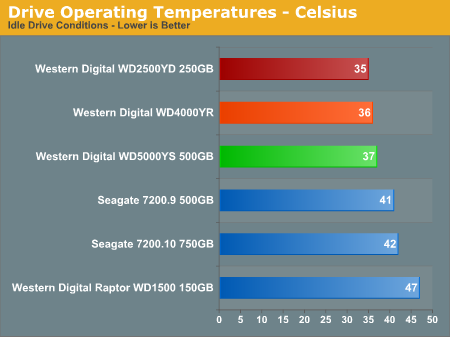Western Digital WD2500YD: Enterprise on the Desktop
by Gary Key on June 24, 2006 10:00 AM EST- Posted in
- Storage
Acoustics
We have revised our acoustics testing methodology. Our acoustic test utilizes our standard test bed components but we implement AMD's Cool'n'Quiet technology and turn off the case fans to isolate as much case noise as possible during testing. Our OCZ power supply is virtually silent in these tests along with our fanless Asus 7600GS video card providing a further decrease in our case's acoustical ambience.
Our acoustic tests are designed to measure the decibel levels while the system is at idle and also under load while running the General Hard Disk Drive Usage benchmark within PCMark 2005. We found through trail and error this particular benchmark produces controlled readings across a wide range of applications within the benchmark. This particular benchmark utilizes 60% reads and 40% writes within the trace playback file.
The measurements are taken at a distance of 5 millimeters from the rear and front of the drive being tested in order to minimize surrounding environmental noise. The reported measurements are based on an A-weighted decibel score that measures frequencies similar to the way the human ear responds to sound. We take a total of three measurements for each test. We then subtract the high and low scores and arrive at our findings by reporting the remaining score.


The WD2500YD is one of the quietest drives we have ever tested. In fact, the current RE and RE2 lineup are very quiet at idle and while under load. Our subjective opinion is that the seek requests are very muted for this drive and it was difficult to notice the drive's noise levels over the power supply fan during most read/write operations. We did notice a slight thumping noise in our Nero Recode benchmark that would occur during continuous data streaming. Our base db(A) level in the room at time of testing was 24 db(A).
Thermals
Our thermal tests utilize sensor readings via the S.M.A.R.T. (Self-Monitoring, Analysis and Reporting Technology) capability of the drives and are reported by utilizing the Active SMART 2.42 utility. We test our drives in an enclosed case environment without the front fan operational to simulate temperatures that could conceivably be reached in a SFF or HTPC case design. We typically find the reported numbers drop anywhere from 18% to 25% on average when the front fan is operational.


We expected the WD2500YD to run cool due to its size and platter count. It did not disappoint us in either test as even the casing remained cool to the touch after hours of continuous testing. Remember that these results represent something of a worst-case scenario, as they are recorded in an enclosed Gigabyte case without the front fan operating. If you plan on using a quiet/poorly ventilated inflated case, you'll want to pay attention to these results.
Both the RE2 drives also ran very cool, but the casings were significantly warmer after continuous operation compared to the RE 250GB drive. Our room temperature at time of testing remained a stable 21C. The WD Raptor and the Seagate drives operated at significantly higher temperatures, although both are within their operating specifications. It is unlikely that higher temperatures would immediately cause a drive failure, but they can reduce the lifespan of a hard drive. We highly recommend cooling the hotter drives with a fan or by some other means.
We have revised our acoustics testing methodology. Our acoustic test utilizes our standard test bed components but we implement AMD's Cool'n'Quiet technology and turn off the case fans to isolate as much case noise as possible during testing. Our OCZ power supply is virtually silent in these tests along with our fanless Asus 7600GS video card providing a further decrease in our case's acoustical ambience.
Our acoustic tests are designed to measure the decibel levels while the system is at idle and also under load while running the General Hard Disk Drive Usage benchmark within PCMark 2005. We found through trail and error this particular benchmark produces controlled readings across a wide range of applications within the benchmark. This particular benchmark utilizes 60% reads and 40% writes within the trace playback file.
The measurements are taken at a distance of 5 millimeters from the rear and front of the drive being tested in order to minimize surrounding environmental noise. The reported measurements are based on an A-weighted decibel score that measures frequencies similar to the way the human ear responds to sound. We take a total of three measurements for each test. We then subtract the high and low scores and arrive at our findings by reporting the remaining score.


The WD2500YD is one of the quietest drives we have ever tested. In fact, the current RE and RE2 lineup are very quiet at idle and while under load. Our subjective opinion is that the seek requests are very muted for this drive and it was difficult to notice the drive's noise levels over the power supply fan during most read/write operations. We did notice a slight thumping noise in our Nero Recode benchmark that would occur during continuous data streaming. Our base db(A) level in the room at time of testing was 24 db(A).
Thermals
Our thermal tests utilize sensor readings via the S.M.A.R.T. (Self-Monitoring, Analysis and Reporting Technology) capability of the drives and are reported by utilizing the Active SMART 2.42 utility. We test our drives in an enclosed case environment without the front fan operational to simulate temperatures that could conceivably be reached in a SFF or HTPC case design. We typically find the reported numbers drop anywhere from 18% to 25% on average when the front fan is operational.


We expected the WD2500YD to run cool due to its size and platter count. It did not disappoint us in either test as even the casing remained cool to the touch after hours of continuous testing. Remember that these results represent something of a worst-case scenario, as they are recorded in an enclosed Gigabyte case without the front fan operating. If you plan on using a quiet/poorly ventilated inflated case, you'll want to pay attention to these results.
Both the RE2 drives also ran very cool, but the casings were significantly warmer after continuous operation compared to the RE 250GB drive. Our room temperature at time of testing remained a stable 21C. The WD Raptor and the Seagate drives operated at significantly higher temperatures, although both are within their operating specifications. It is unlikely that higher temperatures would immediately cause a drive failure, but they can reduce the lifespan of a hard drive. We highly recommend cooling the hotter drives with a fan or by some other means.










11 Comments
View All Comments
driveguy - Monday, June 26, 2006 - link
I do not understand why the YD family was reviewed so late in it's life.The YS familily has been introduced from 160-500GB on a common platform.
It would make much more sense to review the current product.
Gary Key - Monday, June 26, 2006 - link
We reviewed the recent product life update to the YD family that changed it to the RE16 family with 16MB cache and 3GB/s SATA support. The YS family (160GB~320GB range) just started shipping in volume earlier this month and samples are arriving shortly in the 160GB and 250GB sizes. We received the 320GB YS today that will be tested against the other 320GB drives from Western Digital and Seagate in the near future. Thank you for the comments.
driveguy - Tuesday, June 27, 2006 - link
Hi Gary,Thank you for your response.
YS goes from 160GB to 500GB. The real attraction for the RE products is reliability more than performance. This is really not something you can review because you will not have access to field failure rates but these drives have done quite well in high duty cycle envirements. They have crushed STX NL models in the market with the absolute lion's share of this market.
Gary Key - Wednesday, June 28, 2006 - link
Hi,I could have been a little clearer in my 160GB~320GB statement, my point was those drive sizes just started shipping in volume this month. The 400GB and 500GB drives were shipping in May although we have not received the 400GB sample yet. I think with the YS series WD has brought the nearline performance up to and at times exceeding the SE16 line now. I think it will be interesting comparing the NL35.2 to the WD YS series since both are new product releases. We are implementing a 16 drive RAID chassis for enterprise/benchmark testing shortly so we should be able to look at some failure rate information this time next year in this market segment.
Thanks...
Squidward - Monday, June 26, 2006 - link
By looking at this article and others I've seen the Raptor is hands down the best drive you can get without going into SCSI drives. How does that apply to real usage, is the difference that notable versus the other drives in this article? I've been considering buying one if the difference is truly noticable, particularly as it applies to game loading times and recording tv programs.tallman45 - Saturday, June 24, 2006 - link
Nice job as always with the review.A more valuable comparison IMHO though would have been like cost competitors such as the new 74GB 16mb cache Raptor and the 7200.10 320gb Seagate. It stands to reason that a $300 150GB Raptor had better outperform a $90 250gb YD
Gary Key - Saturday, June 24, 2006 - link
Hi,We have the new 74GB 16MB cache Raptor arriving in about 10 days. We have completed our testing on the Seagate 320GB 7200.10 and are in the process of completing several other 200GB~320GB drives for a desktop roundup shortly in what we believe is the best price to performance range at this time. Our 500GB roundup and PVR article will be available in late July. As stated in the article we will also do a separate review on RAID performance with both nearline enterprise and desktop drives in the near future. The process of adding additional multi-tasking benchmarks along with doing both hardware (Areca) RAID and soft (nF500) RAID is painstakingly slow. ;->
The other process we have setup is an additional test bench that is currently running previously reviewed drives 24/7 with varying stress tests so we can start reporting on reliability and doing a quick follow-up on the drives performance every few months. In about two weeks, you should start seeing storage articles from us about every 10 days.
Thank you for the comments.
Gary Key - Saturday, June 24, 2006 - link
Where is the edit button? :) I meant to end my reply with "storage reviews from us about every 10 days or less."dhei - Saturday, June 24, 2006 - link
150gig raptor is around $200 now...dhei - Saturday, June 24, 2006 - link
forgot to add the 75gig Raptor is only $130. In terms of pure performance most people would go for the little premium in price for Raptor than more hd space. They just get a 200+gig drive for backup and install main apps on raptor.